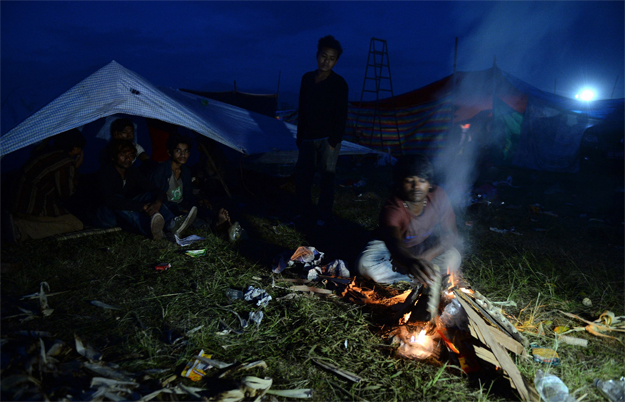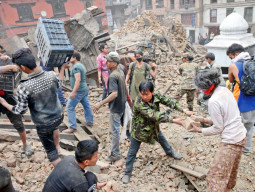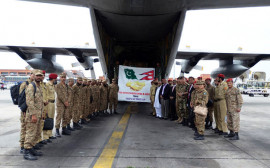
Officials say more than 4,100 people are now known to have died, including 4,010 in Nepal -- making it the quake-prone Himalayan nation's deadliest disaster in more than 80 years.
Around 90 people have been killed in neighboring countries, including at least 67 in India and 20 in China while a further 7,500 people were injured in Nepal.
Families, the sick and elderly packed into parks and other open spaces in Kathmandu after losing their houses, with others too terrified of aftershocks to return home.
"This is a nightmare, why don't these aftershocks stop?" asked 70-year-old Sanu Ranjitkar.
Almost one million children urgently need help following the earthquake, the UN children's agency said, as relief workers raced to help the most vulnerable.
With thousands of children camping out in the open in the capital Kathmandu after their homes were destroyed in Saturday's quake, UNICEF warned of the risk of disease.
"At least 940,000 children living in areas severely affected by (the) earthquake in Nepal are in urgent need of humanitarian assistance," it said in a statement.
"Limited access to safe water and sanitation will put children at great risk from waterborne diseases, while some children may have become separated from their families."
UNICEF said it was mobilising staff and sending two cargo flights with 120 tonnes of humanitarian supplies, including medical and hospital supplies, tents and blankets.
Aid agencies prepare 'massive' operations in quake-hit Nepal http://t.co/qAJcLuvhRM #infographic #NepalEarthquake pic.twitter.com/7j53NJWYa8
— AFP News Agency (@AFP) April 27, 2015
It has also emerged that the quake will set back the already impoverished nation back by many years.
"The total long-term cost of reconstruction in Nepal using appropriate building standards for regions vulnerable to severe earthquakes could exceed $5 billion, which is around 20 per cent of Nepal's GDP," said Rajiv Biswas, Asia-Pacific chief economist at business research firm IHS.
Equipped with heavy cutting gear and accompanied by sniffer dogs, rescue teams were landing round-the-clock at the country's only international airport on the outskirts of Kathmandu, the normally vibrant capital which has been devastated by Saturday's 7.8 magnitude quake.
The earthquake also triggered an avalanche on Mount Everest which buried part of base camp and killed at least 18 people.
Aftershocks triggered fresh avalanches there on Sunday even as helicopters evacuated some of those worst injured the day before.
Hundreds of foreign mountaineers had gathered at the world's highest mountain at the start of the annual climbing season, and the real scale of the disaster there has been impossible to evaluate with communications all but cut off.
With much of Kathmandu lying in ruins, tens of thousands of residents spent the night slept out on the streets, in makeshift tents fashioned from plastic sheeting that did little to protect them from heavy overnight rains.
With the ground still regular shaking from nerve-shredding aftershocks, many endured a sleepless and miserable night.
"We don't have a choice, our house is shaky. The rain is seeping in but what can we do?," said 34-year-old shopkeeper Rabi Shrestha as he camped out on the roadside.
"I don't know why the gods want us to suffer like this."
The situation has been exacerbated by power cuts and the country's cell phone network is at breaking point.
The Nepalese government said it was stepping up efforts to help remote areas closer to the epicentre of the quake.
"Our focus is on rescue," home ministry spokesman Laxmi Prasad Dhakal told AFP. "In far-flung areas, a larger helicopter will be stationed in the regional headquarters and smaller ones will shuttle with survivors."
Announcing the latest death toll in Nepal, a top disaster official said that emergency crews would also step up their efforts to rescue those trapped in high-rise buildings which pancaked on Saturday.
"Our efforts today will also be focused on finding survivors in areas where big buildings have collapsed," Rameshwor Dangal, who heads the home ministry's national disaster management division, told AFP.
The historic nine-storey Dharahara tower, a major tourist attraction, was among the buildings brought down in Kathmandu Saturday.
Police said around 150 people were thought to have been in the tower at the time of the disaster, based on ticket sales.
"At least 30 dead bodies have been pulled out. We don't have a number on the rescued but over 20 injured were helped out," local police official Bishwa Raj Pokharel told AFP.
"We haven't finished our work there, rescue work is still continuing. Right now, we are not in a position to estimate how many might be trapped."
The Nepalese rescuers were being joined by hundreds of foreign aid workers from countries such as China, India and the United States.
Around 70 US aid workers, along with rescue dogs, headed to Nepal aboard a military transport plane which flew from Dover Air Force Base in Delaware.
The European Commission released three million euros ($3.25 million) in emergency aid for Nepal which will help fund clean water, medicine, emergency shelter and telecommunications in the worst-affected areas.
Pledging $10 million in relief to help the victims, US Secretary of State John Kerry said he had been shocked by the "gut-wrenching" images of the death and destruction.
India meanwhile flew in 13 military transport planes loaded with tonnes of food, blankets and other aid.
Hospitals have been overwhelmed by the disaster, with morgues overflowing and medics having to work through the night to cope with an endless stream of victims suffering trauma or multiple fractures.
Some surgeons have been operating from makeshift theatres set up in parking lots with the aftershocks making patients too scared to stay inside.
At the city's oldest Bir Hospital, around a dozen dead bodies had to be placed on the floor, while stricken relatives stood vigil, trying to swat away the flies.
Nepal and the rest of the Himalayas, where the Indian and Eurasia tectonic plates collide, are particularly prone to earthquakes.
An 6.8 magnitude quake hit eastern Nepal in August 1988 killing 721 people, and a magnitude 8.1 quake killed 10,700 people in Nepal and India in 1934.




































1713853507-0/MalalaHilary-(2)1713853507-0-270x192.webp)







COMMENTS (1)
Comments are moderated and generally will be posted if they are on-topic and not abusive.
For more information, please see our Comments FAQ